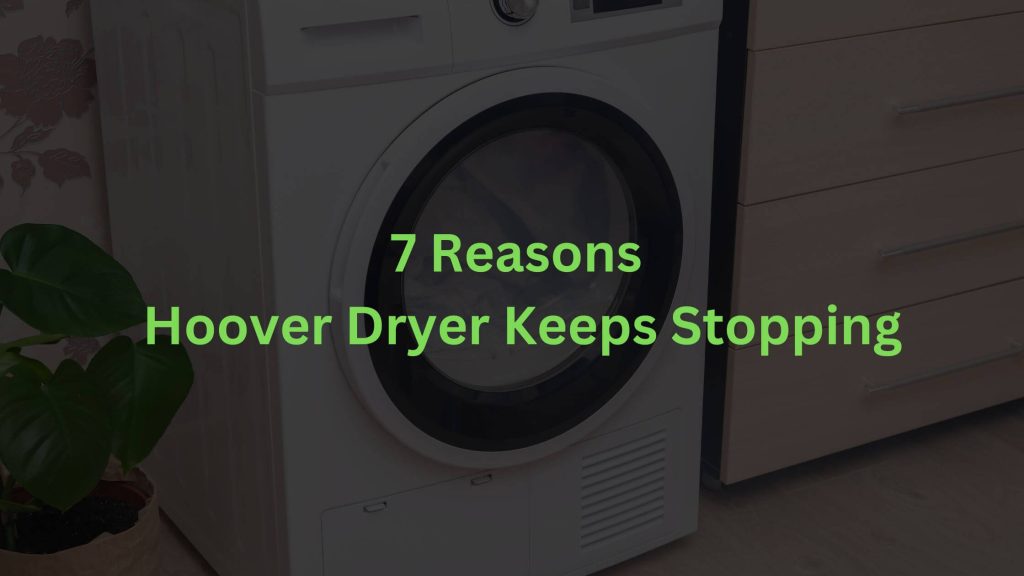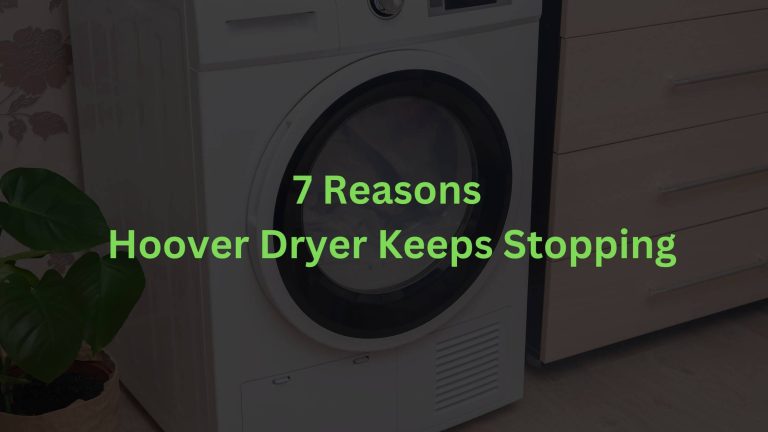One of the most common and frustrating issues is when the dryer keeps stopping mid-cycle or does not start at all.
There are seven possible reasons why your Hoover dryer keeps stopping or does not start. Some of them are easy to fix, while others may require professional assistance.
Here are 7 possible reasons why Hoover dryer keeps stopping:
- Dryer is not getting enough power
- Dryer is overloaded
- Faulty start switch
- Faulty door switch
- Faulty temperature sensor
- Faulty drive motor
- Malfunctioning control board
In this article, we will explore seven of the most common causes and solutions for this problem, and help you get your dryer back to working order.
Table of Contents

Hoover Dryer Keeps Stopping (Solutions)
Here are the common reasons why your dryer keeps stopping.
1. Dryer is not getting enough power
Without sufficient power, your dryer cannot operate properly and may stop unexpectedly or fail to start at all.
How to fix power problem to your dryer:
- Make sure the power cord is plugged in securely and not damaged or frayed. If the cord is loose or broken, replace it.
- Check that the outlet is working and not overloaded. You can test the outlet by plugging in another appliance or using a voltage tester.
- Confirm that the circuit breaker that controls the dryer is not tripped or blown. You can reset the circuit breaker by flipping it off and on. If the circuit breaker keeps tripping or blowing, you may have a wiring problem or a short circuit.
2. Dryer is overloaded
Overloading the dryer can affect its performance and efficiency, as it prevents the hot air from circulating properly and drying the clothes evenly.
Here is what to do:
- Reduce the load size: Do not exceed the maximum capacity of your dryer, which is usually indicated on the label or the user manual.
- Choose the appropriate drying program: Select the right drying program for the type and amount of clothes you are drying. For example, use the cotton program for heavy fabrics and the synthetics program for lighter fabrics.
- Separate different types of fabrics: Sort your laundry by fabric type and weight before drying. For example, separate towels from shirts, jeans from socks, and so on.
3. Faulty start switch
The start switch is the part that you press to turn on the dryer. It sends a signal to the control board and the drive motor to initiate the drying cycle. If the start switch is defective, it may not send the signal or send it intermittently, causing the dryer to not respond or stop after a few seconds.
How to Fix:
- Use a multimeter to check the continuity of the switch. If the switch has continuity when pressed, it is working properly. If the switch does not have continuity when pressed, it is faulty and needs to be replaced.
- Sometimes, the switch may not work because of dirt or dust on the contacts. You can try to clean the contacts with a soft cloth or a cotton swab dipped in alcohol.
- If the switch is faulty or damaged, replace it with a new one.
4. Faulty door switch
The door switch is a safety device that detects when the dryer door is closed and allows the dryer to start or stop accordingly. If the door switch is defective, it may not sense the door position correctly and prevent the dryer from running or stop it prematurely.
How to Fix:
- Check the continuity of the switch with a multimeter. If the switch does not have continuity when the door is closed, it is faulty and needs to be replaced.
- Sometimes, the switch may not work because the door is not aligned properly and does not close the switch. You can try to adjust the door hinges or the latch to ensure a tight fit. You can also check the door seal for any damage or wear that may prevent the door from closing fully.
- If the switch is faulty or damaged, you need to replace it with a new one.
5. Faulty temperature sensor
The temperature sensor is a device that measures the temperature of the air inside the dryer and regulates the heating element accordingly. If the temperature sensor is defective, it may not detect the correct temperature and cause the dryer to not heat up, overheat, or shut off. Some of the signs of a faulty temperature sensor are the dryer displaying error codes, such as E13 or E14.
How to fix:
- Use a multimeter to check the resistance of the sensor. If the sensor has a normal resistance, it is working properly. If the sensor has a high or low resistance, it is faulty and needs to be replaced.
- The sensor may not work because of lint or dust buildup on the sensor. You can try to clean the sensor with a soft cloth or a cotton swab dipped in alcohol.
6. Faulty drive motor
The drive motor is the part that rotates the drum and spins the blower wheel. If the drive motor is defective, it may not be able to turn the drum or the blower wheel, causing the dryer to not spin.
How to Fix:
- The motor may not work because of friction or wear and tear. You can try to lubricate the motor with a few drops of oil on the bearings.
7. Faulty control board
The control board is the electronic unit that controls the programs and settings in your dryer. It may malfunction and end dryer cycles without your command.
How to Fix:
- Reset the board: The board may not work because of a power surge or a glitch. You can try to reset the board by unplugging the dryer for a few minutes and then plugging it back in. This may clear the error codes and restore the normal function of the board.
- Check the wiring: You can inspect the wiring harness that connects the board to the other components of the dryer. Look for any signs of wear, tear, or corrosion. If you find any, you may need to repair or replace the wire.
Conclusion
We have discussed seven of the most common reasons why your Hoover dryer keeps stopping or does not start, and how to fix them.
These reasons are: not getting enough power, overloading, faulty start switch, faulty door switch, faulty temperature sensor, faulty drive motor, and faulty control board.
By following the troubleshooting steps and tips we have provided, you can solve most of the problems yourself and save time and money. However, if you are unsure or unable to fix the problem, you should always contact a professional technician for assistance.
Related Articles:

